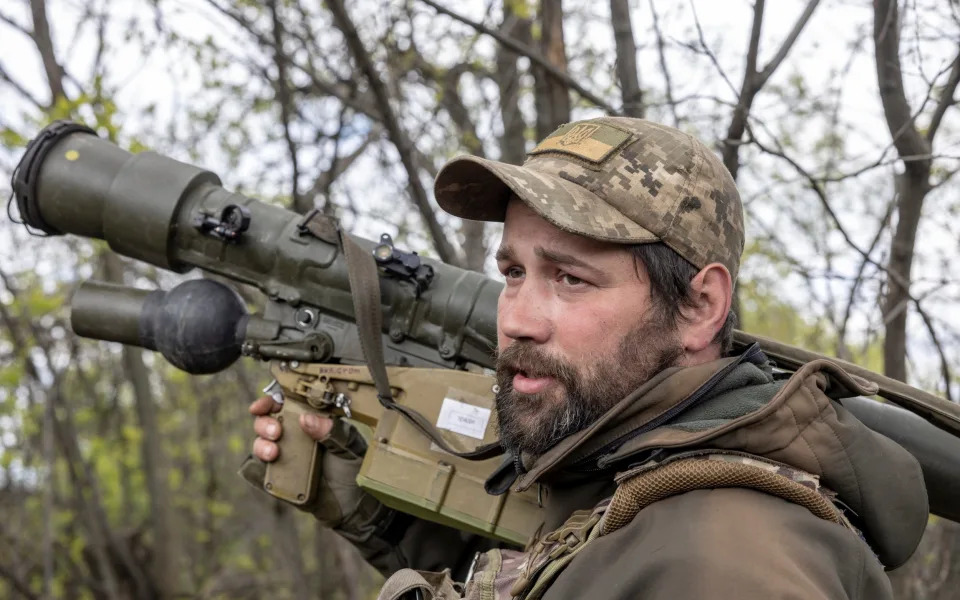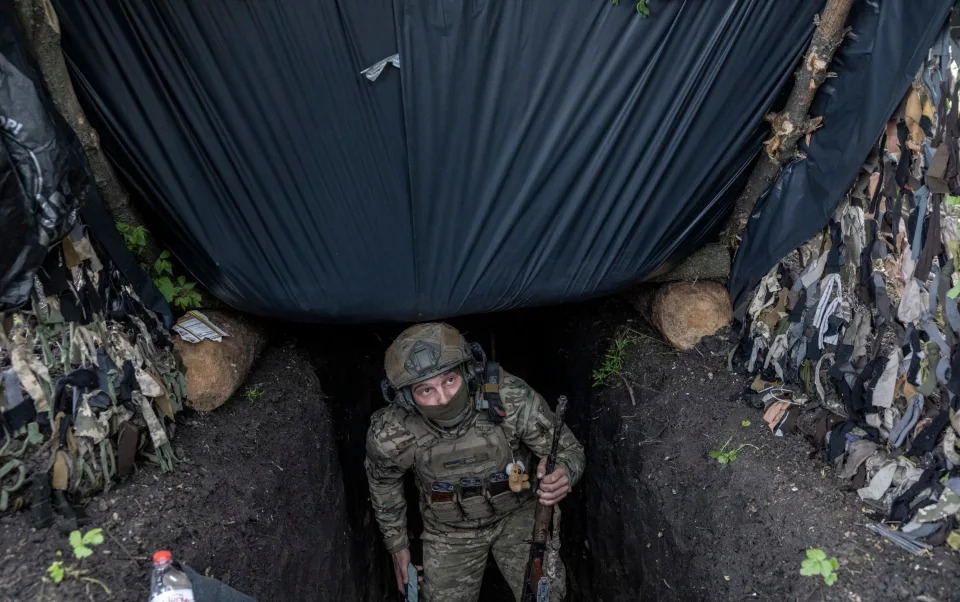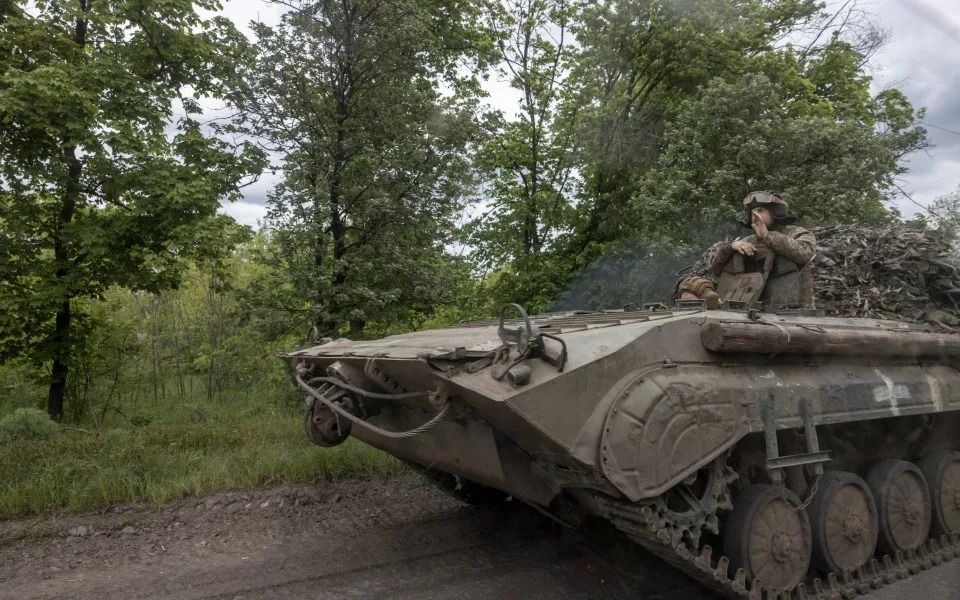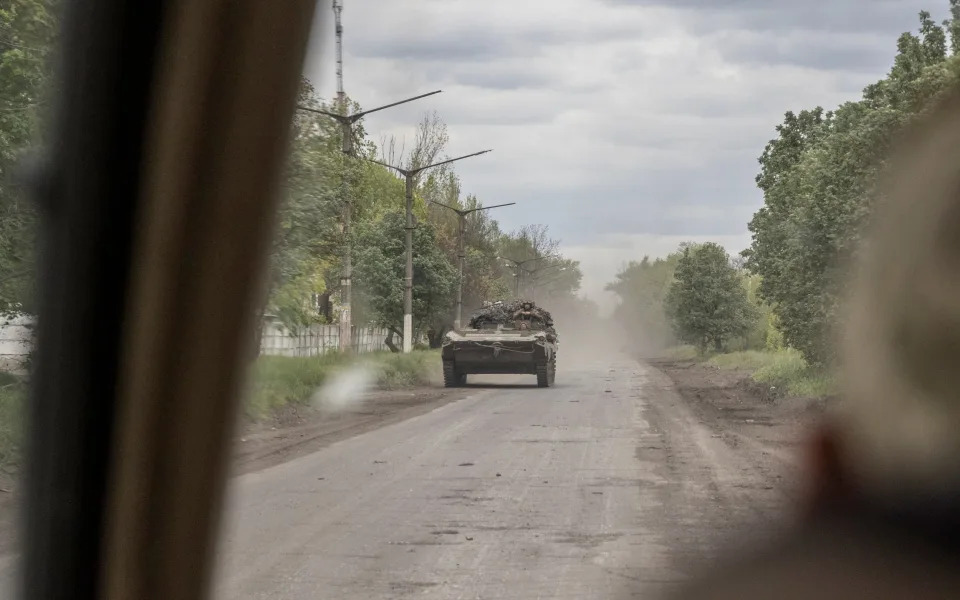The Telegraph
On the front line when Ukraine did the unthinkable in Bakhmut after months of retreat
Roland Oliphant – May 12, 2023

Usually when a multiple rocket launch system is firing you can count the whooshes out and listen to the rapid drum roll as they land.
Not near Bakhmut on Thursday.
So many weapons were firing at once that outgoing booms and incoming rumbles became impossible to distinguish.
Hell was being unleashed on the other side of the ridge but no one would say who was being hit.
“When it happens you’ll hear about it,” said an officer watching the smoke rise on the horizon when asked to explain what on earth was going on. “But only afterwards.”
It did not take a genius to read between the lines.
After nine months of bloody retreat and strict shell rationing, the Ukrainians had not only begun to push back here. They had unleashed one of the loudest artillery barrages of the war.
The long-waited Ukrainian counter-offensive, or at least a part of it, had begun.
No one announced the beginning of the battle. In fact, Ukrainian authorities are playing this battle down.
While the shells were raining down on Thursday, President Volodymyr Zelensky was telling the BBC that Ukraine was still not ready to take the offensive.
On Friday he acknowledged he had “heard a report from General Syrskyi, whose units had made extraordinary efforts to stop the enemy and even pushed it back in some directions”, but again avoided saying anything referring to an attack.
Russia also on Friday admitted it was coming under attack, claiming it had suppressed Ukrainian offensives along 60 miles of the front line around Bakhmut.
The first signs that something was up came on Tuesday, when the Third Separate Assault Brigade, the latest incarnation of the Azov regiment, attacked Russian lines on the southern edge of the Bakhmut salient.
The following day General Oleksandr Syrskyi, the commander of Ukraine’s ground forces, said the Russians had retreated up to 1.2 miles.
It was a respectable but very localised gain that eased pressure on a critical supply road, but on its own meant little.
Then at 2am on Thursday, the 10th Mountain Assault brigade attacked Russian lines near Khromove, a village on the north-western outskirts of the town.
The Russians tried to fight back, firing rockets at Ukrainian tanks and calling in mortars and artillery. But in the end they crumpled.
In a few hours the Ukrainans had advanced about 1,600ft and reinforcements were moving in to consolidate the gains.
It is too early to tell whether this assault on Bakhmut will develop into the main thrust of the much-heralded counter-offensive.
But the fact that the Ukrainians are gaining ground after nine months of exhausting, costly and demoralising urban battle is notable.
And the coordinated assault on both flanks of the attacking Russian force was enough to throw Russia’s pro-war commentariat into panic.
Yevgenny Prigozhin, the head of the Wagner mercenary group, declared the Ukrainian counter-offensive “well under way,” and blamed the Russian army for imminent disaster. He added that Russian forces were fleeing and the “front was collapsing”, a possible exaggeration to fuel his growing feud with the Kremlin.
Maj Gen Igor Konashenkov, the Russian ministry of defence spokesman, on Friday denied any Ukrainian breakthrough and said Russian forces in Bakhmut were “regrouping” in more favourable terrain.
He said that up to 40 tanks and more than 1,000 Ukrainian servicemen were involved in “offensive operations” along a front of around 60 miles.
Time will tell who is telling the truth.
Some of Russia’s more sober pro-war battle bloggers confirmed that its 10th Motor Rifle Brigade had retreated from Khromove and Bogdanova.
That matches the Telegraph’s understanding of developments on the Ukrainian side on Thursday morning.
The bloggers, many of whom are close to the military, appeared to be gripped by panic and predicting disasters all along the front.
Some claimed large numbers of Ukrainian troops had been seen on the move in the Kharkiv region and predicted an offensive in the northeast.
Others firmly asserted the next blow would come in the Zaporizhia region, and that river crossing boats were massing on the Dnipro.
Several repeated a rumour, entirely unsourced, that the Ukrainians were firing “chemical shells that cause loss of consciousness when inhaled” near Orikhiv.
Yevgenny Podubny, one of the most popular Russian military bloggers, even reported a Ukrainian breakthrough to Soledar, which Russia captured in January.
That would have been a remarkable development but remains unconfirmed.
It is possible even the Ukrainian generals themselves do not know what they will do next.

They have at least three other possible axes for the grand offensive: against Svatove in the north; towards Melitopol in the south; and across the Dnipro river near Kherson.
The first would cut a critical Russian supply line for forces in Donbas. The second would sever the “land bridge” between mainland Russia and Crimea, turning the prized peninsula into a trap. The third, though risky, would take advantage of weak Russian defences along the river.
Russia’s generals are all too aware of these options, but until the Ukrainians make a firm commitment one way or the other they cannot be sure where to concentrate their defence.
The Ukrainians will exploit that ambiguity to the full, waiting to judge the Russian response in Bakhmut before deciding where to commit more reserves for a breakthrough.
The point is not to kill every Russian in Ukraine, or even to retake every inch of land. But a severe battlefield shock would cause political reverberations in Moscow.
Bakhmut would be a good place for that.

This week’s attacks on the Russian north and south flanks seem to have been aimed initially at pushing the troops back from the critical supply roads.
But if they go further they could develop into a pincer movement of their own – potentially leading to an encirclement of thousands of Russians committed to the assault on the city.
There are tantalising historic precedents for such a reversal.
In November 1942, Nazi Germany’s sixth army was on the verge of victory in Stalingrad after months of gruelling urban warfare.
A sudden Soviet counter-offensive on the flanks left the Germans themselves surrounded and led to a devastating defeat from which the Nazis never recovered.
A similar encirclement of the Russians at Bakhmut might just provide the kind of shock to cause chaos in Moscow. It is a scenario that many top officials in Kyiv believe is the most likely way to end the war.
It is almost impossible to tell how the battle is actually going at the front.
Journalists have not been allowed anywhere near the assault and the Ukrainians have been very good at concealing their intentions.
Images selectively released by Ukrainian units show very close-quarters firefights involving infantry and armoured vehicles working closely together.
Body camera footage released by the Third Assault Brigade showed infantry dismounting from an armoured vehicle before engaging unseen enemies in fields and trench systems.
A grenade lands and explodes close to the man wearing the camera but he appears to be unhurt.
The troops are then seen throwing their own grenades into Russian dugouts as they clear positions.
Another video shows Ukrainians walking past several dead Russians lining a trench. They appear to have been killed by artillery.

A drone video purportedly filmed during the battle showed Ukrainian infantry and a tank fighting at extremely close quarters with Russians in a treeline.
Those journalists who happened to catch a glimpse of the start of the operation were there by accident.
One Ukrainian news crew who emerged grimy and dazed from the battlefield on Thursday morning had been doing a routine front-line visit when they got swept up in the attack.
Bohdan Kutpiepov, a Ukrainian documentary maker, was on his last day of filming a documentary about a medical unit when he realised he might be witnessing the first day of the spring offensive.
“In just a few hours, I experienced so many emotions that I don’t even want to begin to describe them here,” he wrote on Facebook.
He ended with a photograph of a wounded Ukrainian soldier, a reminder, he said, of the cost of liberation.
The Telegraph happened to be visiting an air defence echelon of the 80th airborne brigade near Chasiv Yar, the heavily shelled town controlling the last supply road into Bakhmut.
Their job is to lurk in camouflaged positions and wait for Russian drones – helicopters and jets don’t dare cross the lines these days – before popping up and zapping them with shoulder-launched rockets.
Most of them had no more idea what was going on under the barrage than we did.
“Is that yours?” I asked Mikhailo, the sergeant from Lviv in charge of a squad carrying shoulder-mounted air defence systems next to me as we watched smoke on the horizon after a particularly loud salvo.
“Nope,” he said, unsmiling. “Not us firing that.”
Something else opened up nearby
“Cannon,” said Mikhailo. A howitzer was clearly concealed in the trees behind us.
Then a heavy machine gun. Someone had spotted a drone.
The 80th is one of the Ukraine army’s most seasoned spearhead infantry units.
While new brigades trained for the coming offensive they, along with other veteran units such as the 93rd and 92nd mechanised brigades, have been holding the line in what has become Ukraine’s Verdun.
The soldiers thought they had arrived around January. Or was it February? Time telescopes in war, and many of them have been in combat since the invasion began.
On verge of being cut off
Back then, almost everyone here – soldiers, civilians, foreign volunteers – considered the Ukrainian position impossible.
Russian flank attacks had made breakthroughs to the north and south, the last remaining supply roads were under heavy fire and were on the verge of being cut altogether.
Chasiv Yar, the last town astride the last road in, was coming under increasingly heavy fire and was being evacuated ahead of the inevitable siege.
Even American officials were urging Ukrainian commanders to get out before they were encircled, according to Pentagon intelligence briefings leaked online.
“I remember that moment. I also thought Bakhmut would have to be given up,” said Mikhailo, the commander of a Strela-10 air defence system hidden in a treeline near the town. “But our guys wouldn’t give up our land.”
Like everyone, they are mostly relying on old Soviet kit, despite high-profile deliveries of Western weapons.
Mikhailo’s Strela was built in 1980, has no radar and relies on the operator’s eyes to spot incoming targets.
That means it cannot work at night and although it can fire in 30 seconds, sometimes it misses targets.
“I’d like a Gepard,” said Mikhailo, referring to a German anti-aircraft system. “It would solve all those problems.”
His commanding officer, who asked to remain anonymous, repeats the request when asked what he needs: “Gepard.”
One man who was caught up in the Ukrainian offensive on Thursday said the Russians had started “answering hard” at the front.
On May 9, the day the first Ukrainian attack began, a Russian grad strike near Chasiv Yar killed Armand Soldin, an Agence France Press reporter on assignment in the area.
The Ukrainian military never comments on its own casualties but everyone knows it has fewer men to lose than Russia.
Then there is the risk of a Russian counter-strike elsewhere.
For months, Ukrainian commanders and soldiers on other parts of the 600-mile front have quietly complained about the vortex of Bakhmut leaving them vulnerable.
The Donbas town has become a black hole with a gravitational pull out of all proportion to its size, sucking up men, weapons and ammunition that other units could also have put to good use.
One artillery man on another part of the frontline told The Telegraph this week that he is still painfully short of shells.
Fortunately, he said, the Russians in his area seem to be in the same predicament, so both sides are avoiding a fight.
But if that changes while most Ukrainian forces are concentrated for assaults elsewhere, his and other under-equipped units may find themselves in serious trouble.
Ukrainian commanders will be hoping the Russians do not have the resources or intelligence to find and exploit those weak points.
And the Russians, too, have a problem with concentration of force. Even their army cannot provide enough men to hold every inch of the front.
The greatest risk of all is political.
Mr Zelensky’s reticence about announcing the offensive is partly simple misdirection.
But he has also worried about disappointment. Both he and Oleksii Reznikov, his defence minister, have recently warned against inflated expectations.
The concern is that Western countries impatient for a quick end to the war will lose the stomach to continue to support the country if gains are not quick and spectacular.
The possibility of Donald Trump, who has openly questioned support for Ukraine, returning to the White House in 2024 adds to the time pressure.
Four months since Bakhmut seemed doomed, the tide of the battle – and of the war – may be changing here.
Every window in Chasiv Yar has been blown out. One road is still, but barely, open. And the 93rd are still clinging on to a tiny foothold in Bakhmut’s western-most suburbs.
But the attitude of the troops has changed remarkably.
Gone is the sense of impending doom. Instead, there is an indefinable confidence of men who have a feeling it is going to be all right.
“You’re not scared, being here?” asked another Mikhailo in the brigade, as a salvo rolled across the landscape.
“I mean, who isn’t? I’d much rather be sitting at home.” He shrugged and pointed out at the field in front of us. “Don’t film it, but there’s 40 craters there. It was all last week.”
He looked back at the smoke on the horizon. “Yeah, we’re waiting for the offensive. Everyone is waiting.”
